Cultural Diversity at INPEX: Japan-Australia Business Analysis
VerifiedAdded on 2023/05/23
|13
|1210
|109
Essay
AI Summary
This essay provides a cross-cultural analysis of INPEX Corporation, a Japanese multinational operating in Australia, focusing on the cultural diversity and its impact on business practices. It examines the cultural differences between Japan and Australia through the lens of Hofstede's five dimensions of culture: collectivism versus individualism, feminism versus masculinity, power distance, long-term versus short-term orientation, and uncertainty avoidance. The analysis highlights the contrasting approaches to social relationships, power distribution, and social control, noting potential frustrations and misunderstandings arising from these differences. Ultimately, the essay emphasizes the importance of cultural understanding and adaptation for successful cross-cultural communication and business negotiations between the two nations. Desklib offers this essay and many other solved assignments for students.
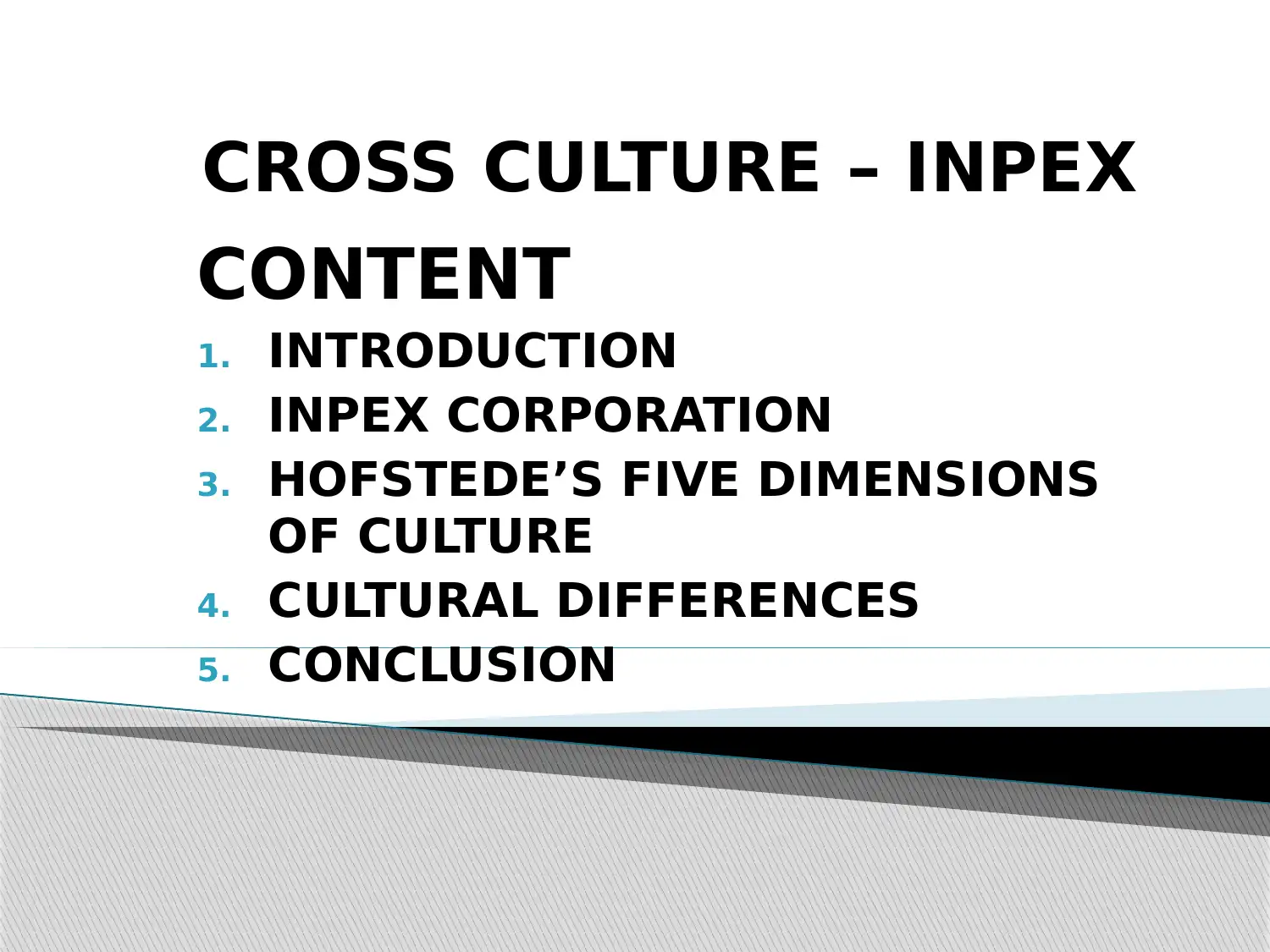
CROSS CULTURE – INPEX
CONTENT
1. INTRODUCTION
2. INPEX CORPORATION
3. HOFSTEDE’S FIVE DIMENSIONS
OF CULTURE
4. CULTURAL DIFFERENCES
5. CONCLUSION
CONTENT
1. INTRODUCTION
2. INPEX CORPORATION
3. HOFSTEDE’S FIVE DIMENSIONS
OF CULTURE
4. CULTURAL DIFFERENCES
5. CONCLUSION
Paraphrase This Document
Need a fresh take? Get an instant paraphrase of this document with our AI Paraphraser
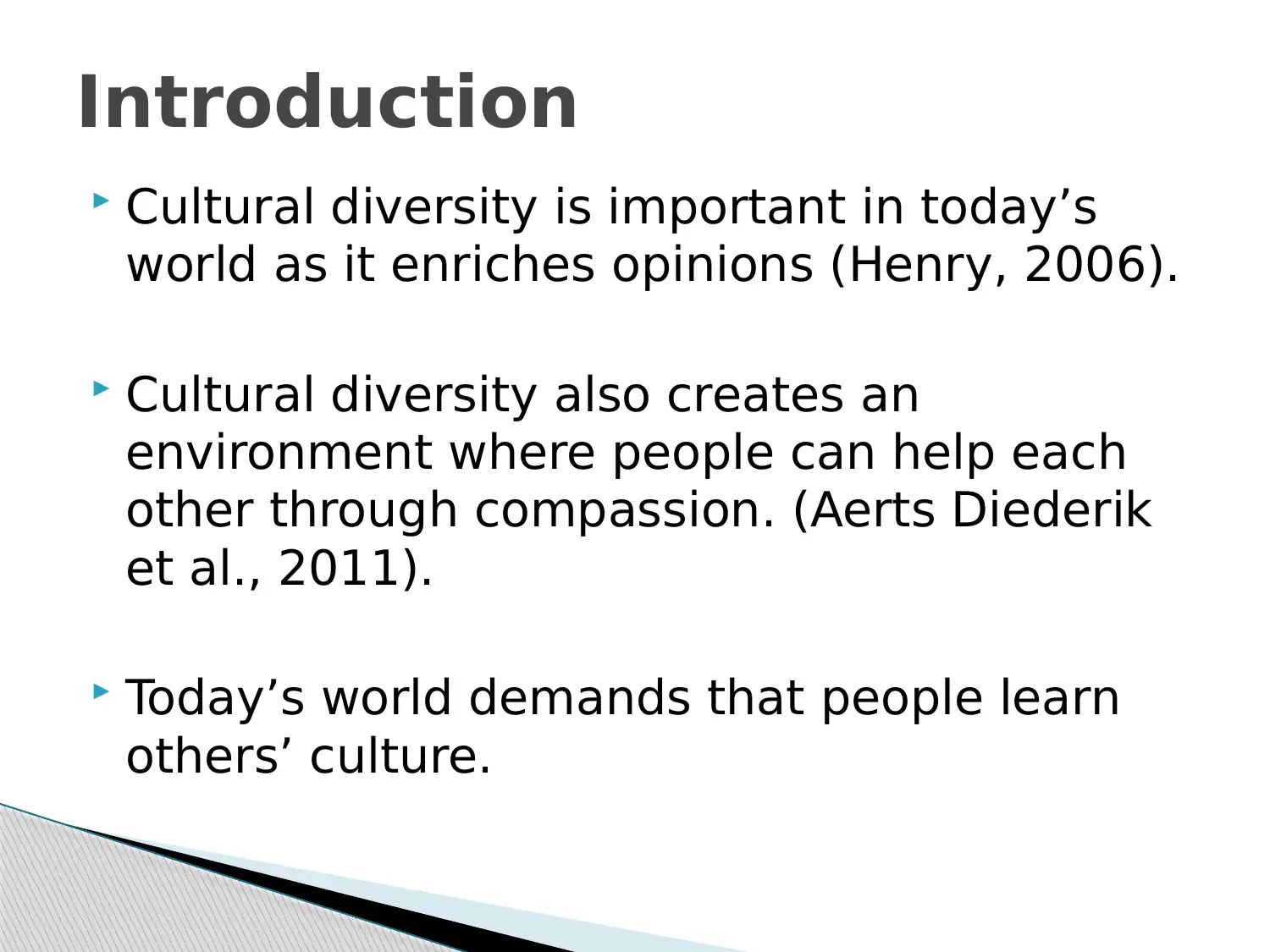
Cultural diversity is important in today’s
world as it enriches opinions (Henry, 2006).
Cultural diversity also creates an
environment where people can help each
other through compassion. (Aerts Diederik
et al., 2011).
Today’s world demands that people learn
others’ culture.
Introduction
world as it enriches opinions (Henry, 2006).
Cultural diversity also creates an
environment where people can help each
other through compassion. (Aerts Diederik
et al., 2011).
Today’s world demands that people learn
others’ culture.
Introduction
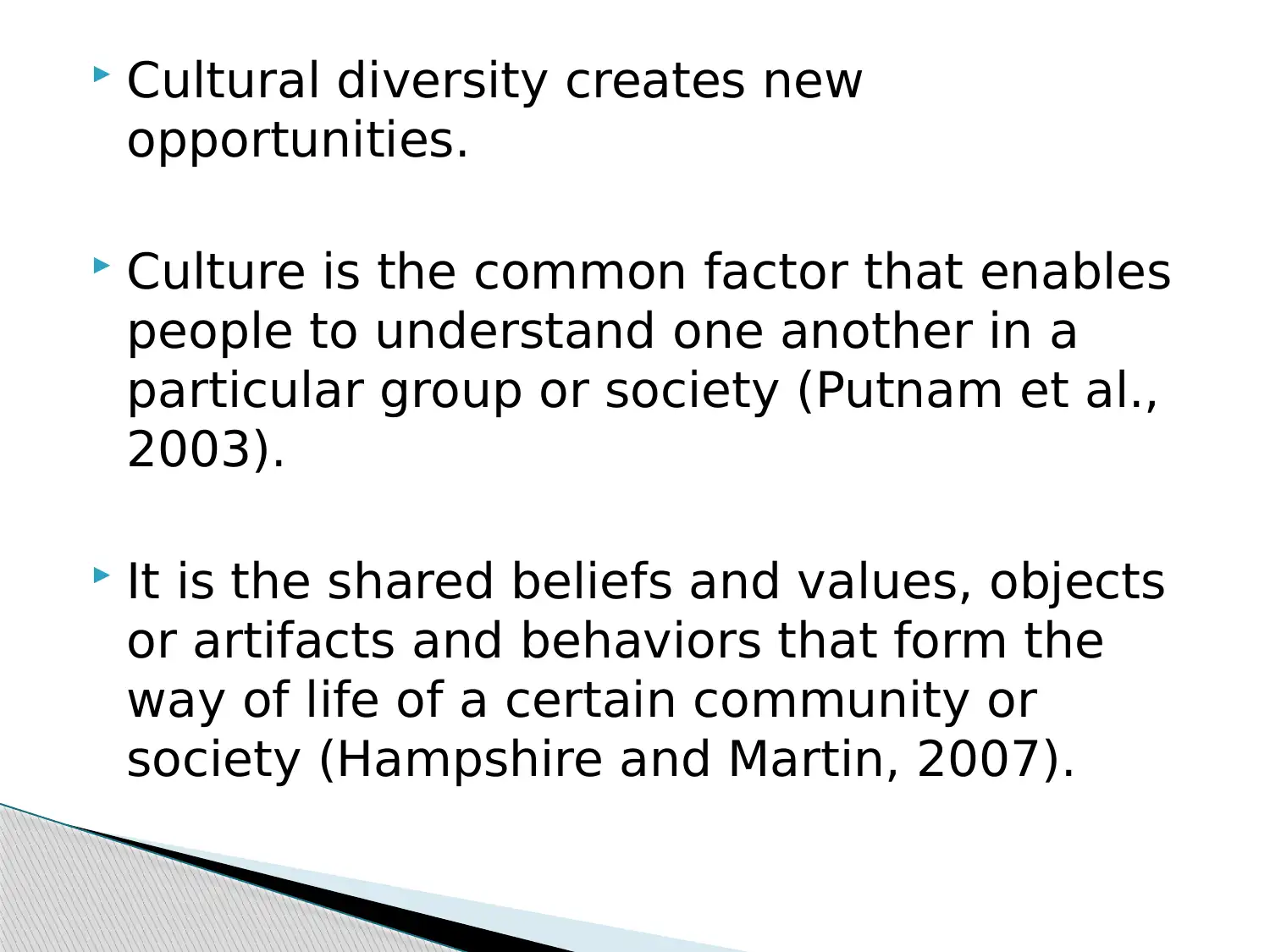
Cultural diversity creates new
opportunities.
Culture is the common factor that enables
people to understand one another in a
particular group or society (Putnam et al.,
2003).
It is the shared beliefs and values, objects
or artifacts and behaviors that form the
way of life of a certain community or
society (Hampshire and Martin, 2007).
opportunities.
Culture is the common factor that enables
people to understand one another in a
particular group or society (Putnam et al.,
2003).
It is the shared beliefs and values, objects
or artifacts and behaviors that form the
way of life of a certain community or
society (Hampshire and Martin, 2007).
⊘ This is a preview!⊘
Do you want full access?
Subscribe today to unlock all pages.

Trusted by 1+ million students worldwide
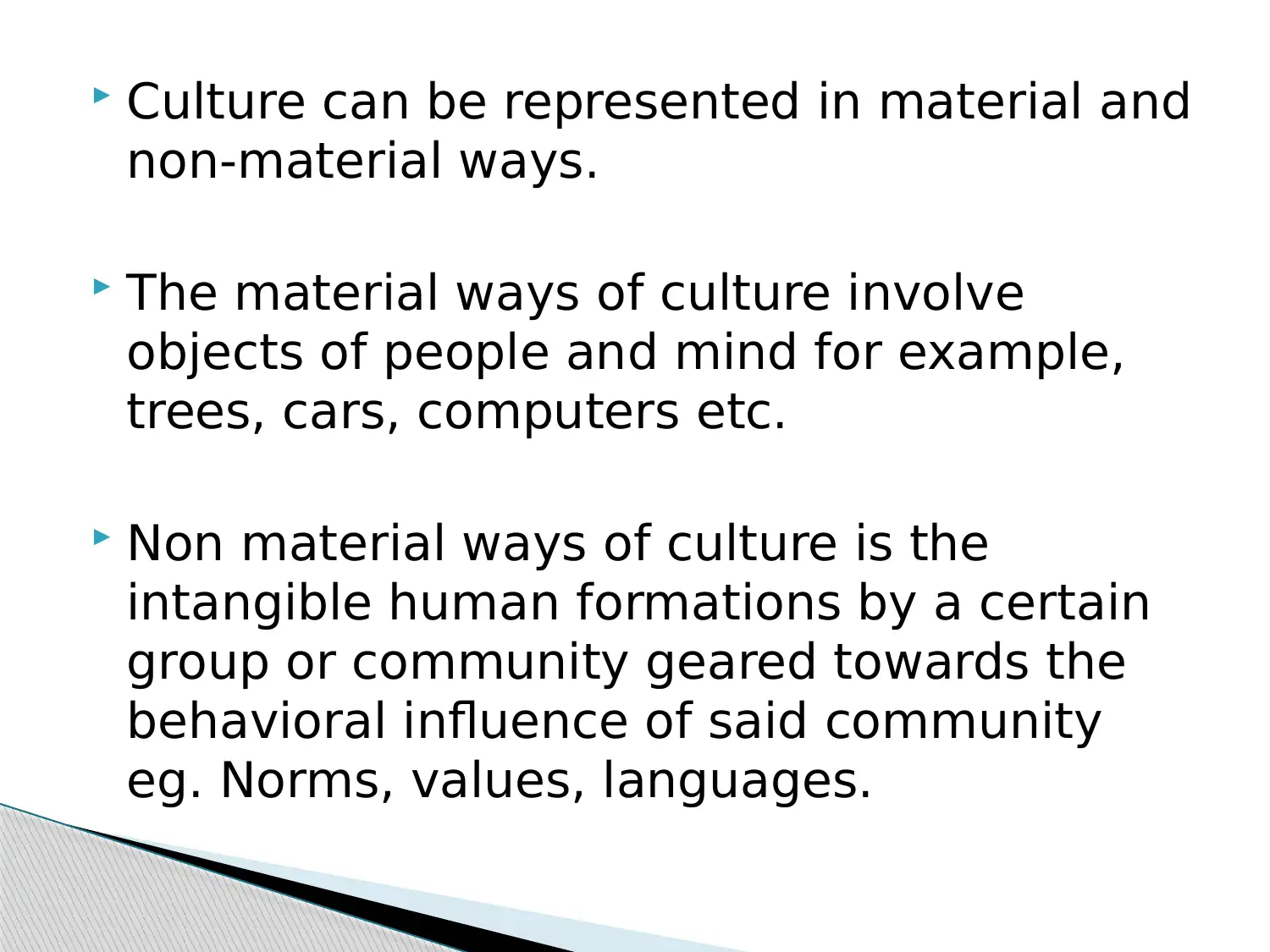
Culture can be represented in material and
non-material ways.
The material ways of culture involve
objects of people and mind for example,
trees, cars, computers etc.
Non material ways of culture is the
intangible human formations by a certain
group or community geared towards the
behavioral influence of said community
eg. Norms, values, languages.
non-material ways.
The material ways of culture involve
objects of people and mind for example,
trees, cars, computers etc.
Non material ways of culture is the
intangible human formations by a certain
group or community geared towards the
behavioral influence of said community
eg. Norms, values, languages.
Paraphrase This Document
Need a fresh take? Get an instant paraphrase of this document with our AI Paraphraser
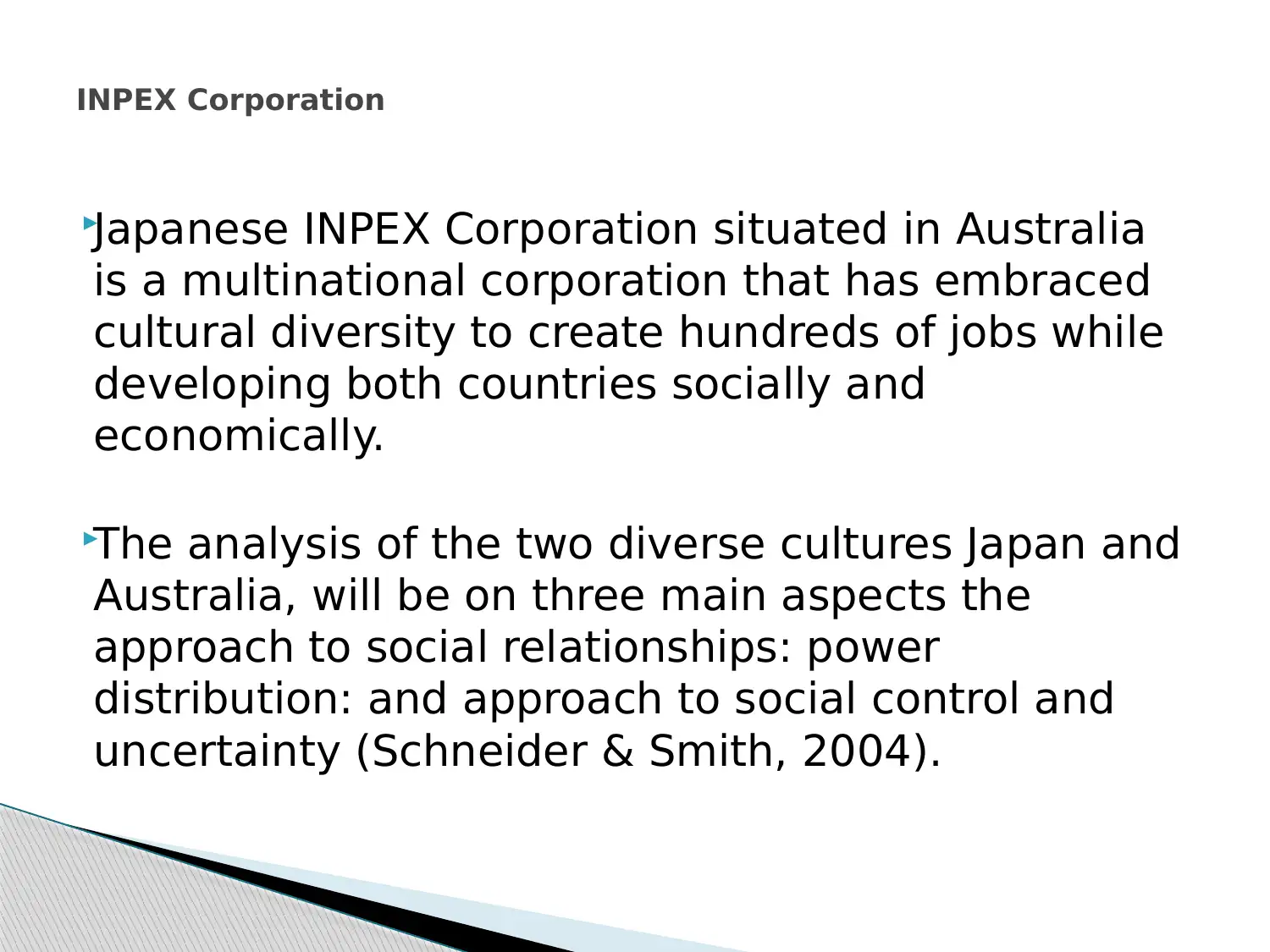
Japanese INPEX Corporation situated in Australia
is a multinational corporation that has embraced
cultural diversity to create hundreds of jobs while
developing both countries socially and
economically.
The analysis of the two diverse cultures Japan and
Australia, will be on three main aspects the
approach to social relationships: power
distribution: and approach to social control and
uncertainty (Schneider & Smith, 2004).
INPEX Corporation
is a multinational corporation that has embraced
cultural diversity to create hundreds of jobs while
developing both countries socially and
economically.
The analysis of the two diverse cultures Japan and
Australia, will be on three main aspects the
approach to social relationships: power
distribution: and approach to social control and
uncertainty (Schneider & Smith, 2004).
INPEX Corporation
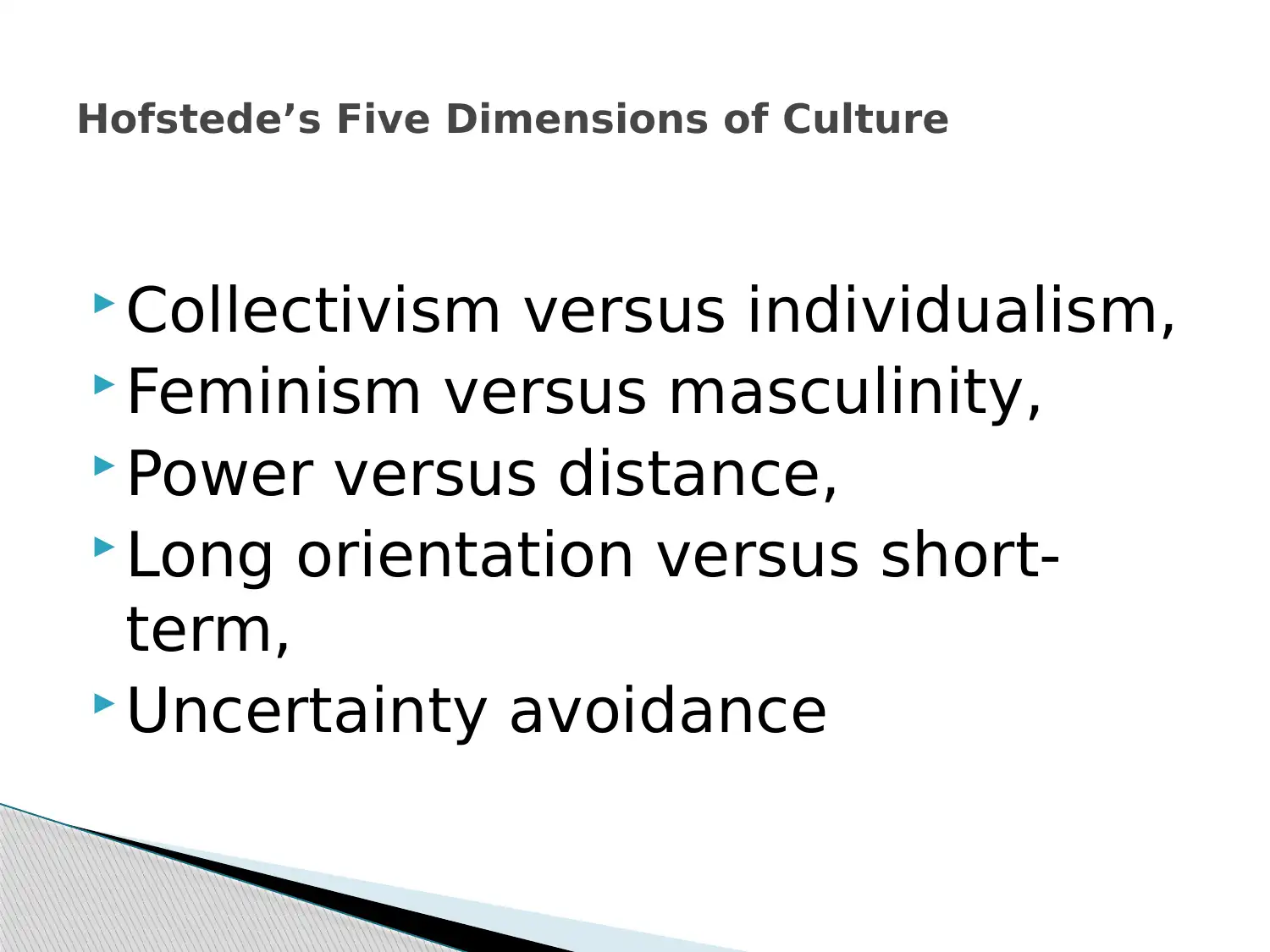
Collectivism versus individualism,
Feminism versus masculinity,
Power versus distance,
Long orientation versus short-
term,
Uncertainty avoidance
Hofstede’s Five Dimensions of Culture
Feminism versus masculinity,
Power versus distance,
Long orientation versus short-
term,
Uncertainty avoidance
Hofstede’s Five Dimensions of Culture
⊘ This is a preview!⊘
Do you want full access?
Subscribe today to unlock all pages.

Trusted by 1+ million students worldwide
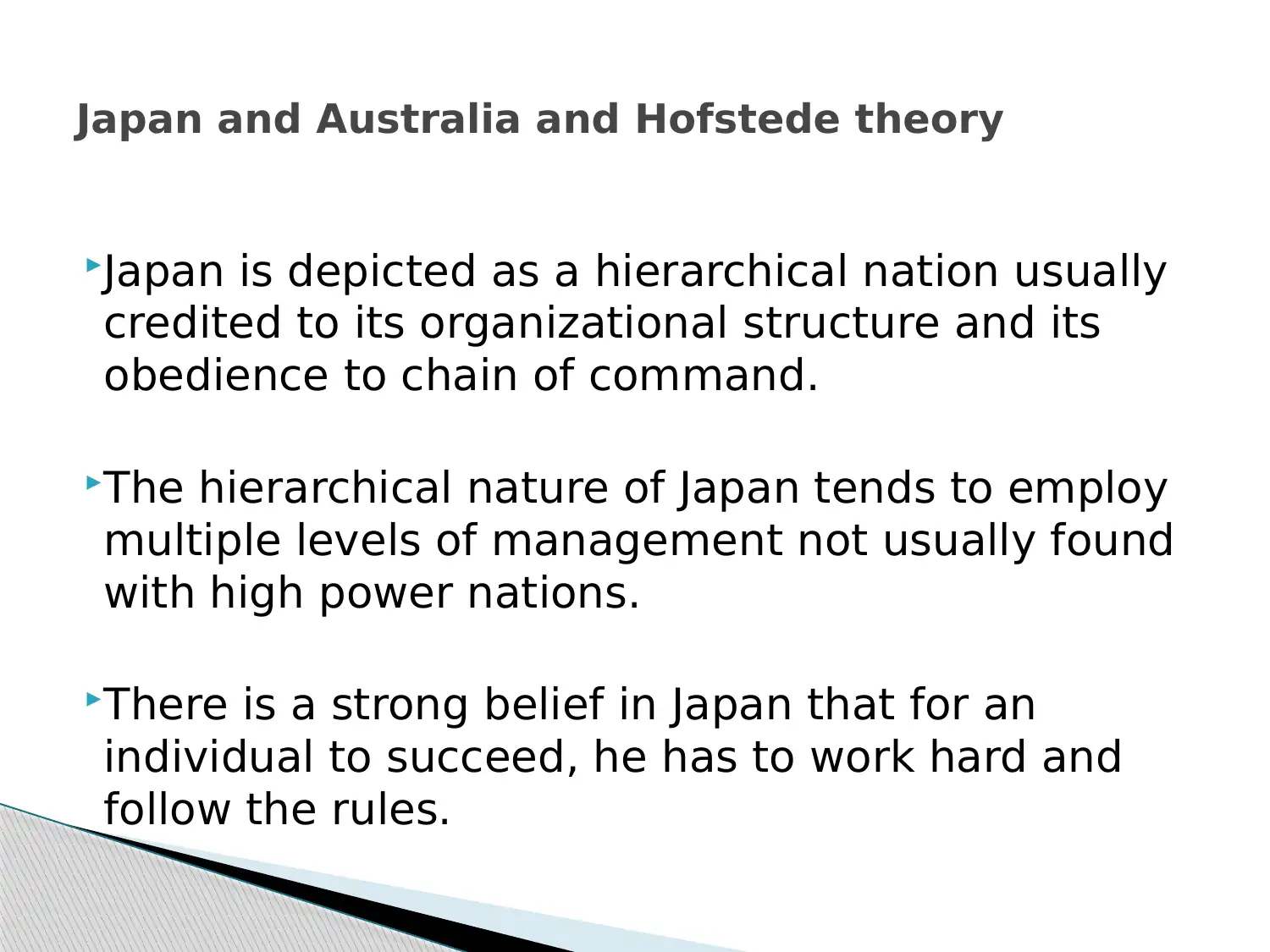
Japan is depicted as a hierarchical nation usually
credited to its organizational structure and its
obedience to chain of command.
The hierarchical nature of Japan tends to employ
multiple levels of management not usually found
with high power nations.
There is a strong belief in Japan that for an
individual to succeed, he has to work hard and
follow the rules.
Japan and Australia and Hofstede theory
credited to its organizational structure and its
obedience to chain of command.
The hierarchical nature of Japan tends to employ
multiple levels of management not usually found
with high power nations.
There is a strong belief in Japan that for an
individual to succeed, he has to work hard and
follow the rules.
Japan and Australia and Hofstede theory
Paraphrase This Document
Need a fresh take? Get an instant paraphrase of this document with our AI Paraphraser
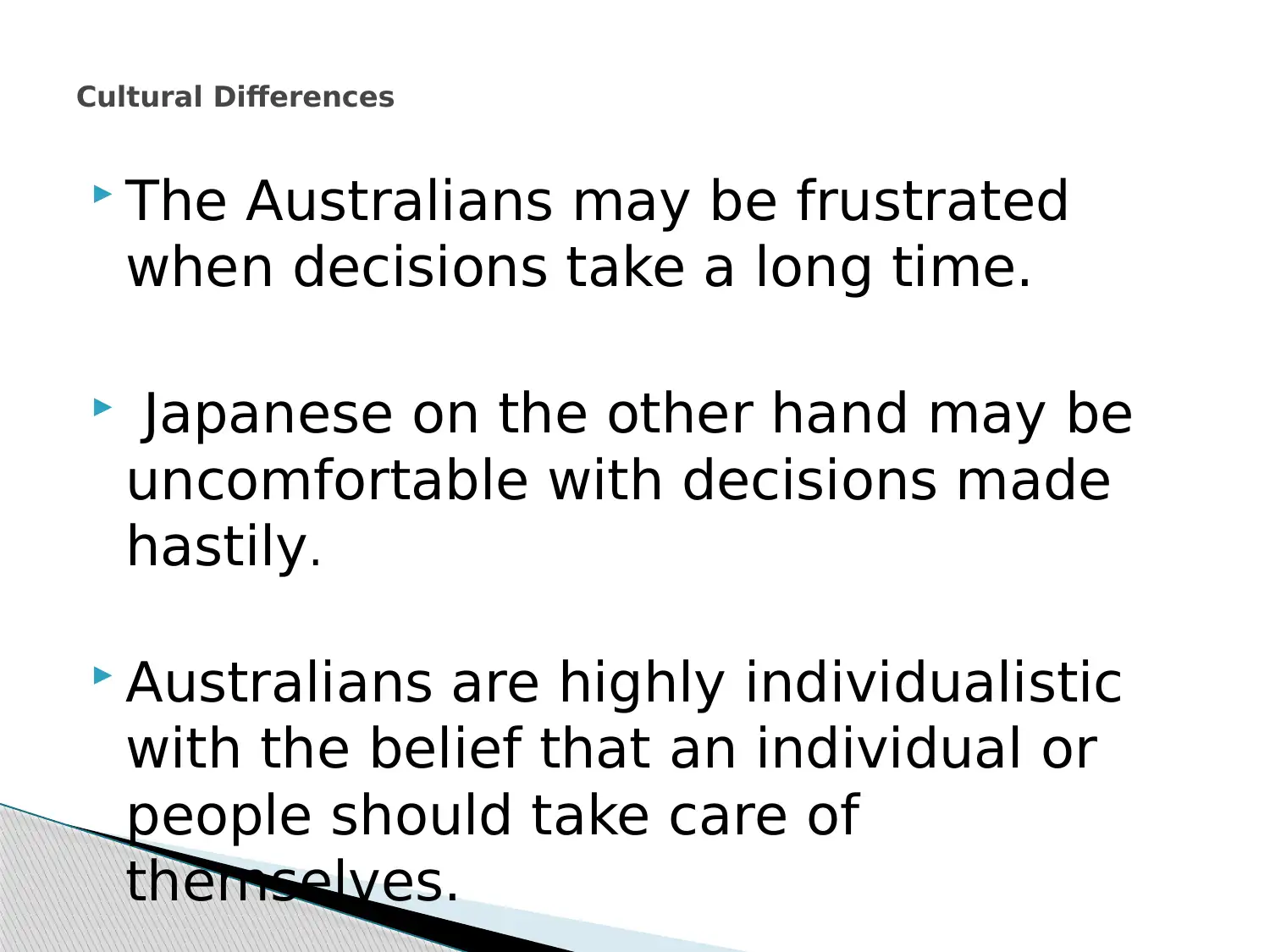
The Australians may be frustrated
when decisions take a long time.
Japanese on the other hand may be
uncomfortable with decisions made
hastily.
Australians are highly individualistic
with the belief that an individual or
people should take care of
themselves.
Cultural Differences
when decisions take a long time.
Japanese on the other hand may be
uncomfortable with decisions made
hastily.
Australians are highly individualistic
with the belief that an individual or
people should take care of
themselves.
Cultural Differences
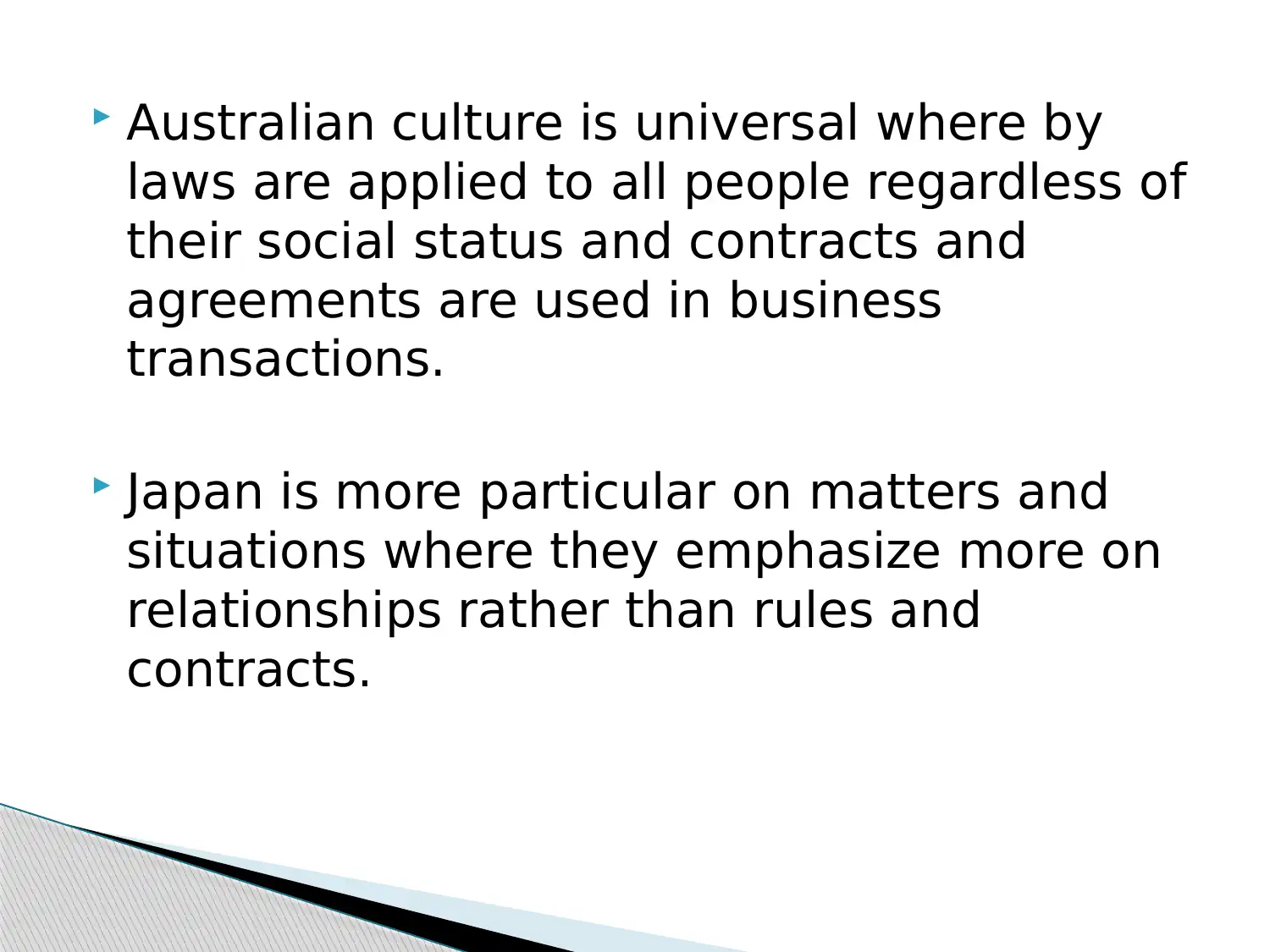
Australian culture is universal where by
laws are applied to all people regardless of
their social status and contracts and
agreements are used in business
transactions.
Japan is more particular on matters and
situations where they emphasize more on
relationships rather than rules and
contracts.
laws are applied to all people regardless of
their social status and contracts and
agreements are used in business
transactions.
Japan is more particular on matters and
situations where they emphasize more on
relationships rather than rules and
contracts.
⊘ This is a preview!⊘
Do you want full access?
Subscribe today to unlock all pages.

Trusted by 1+ million students worldwide
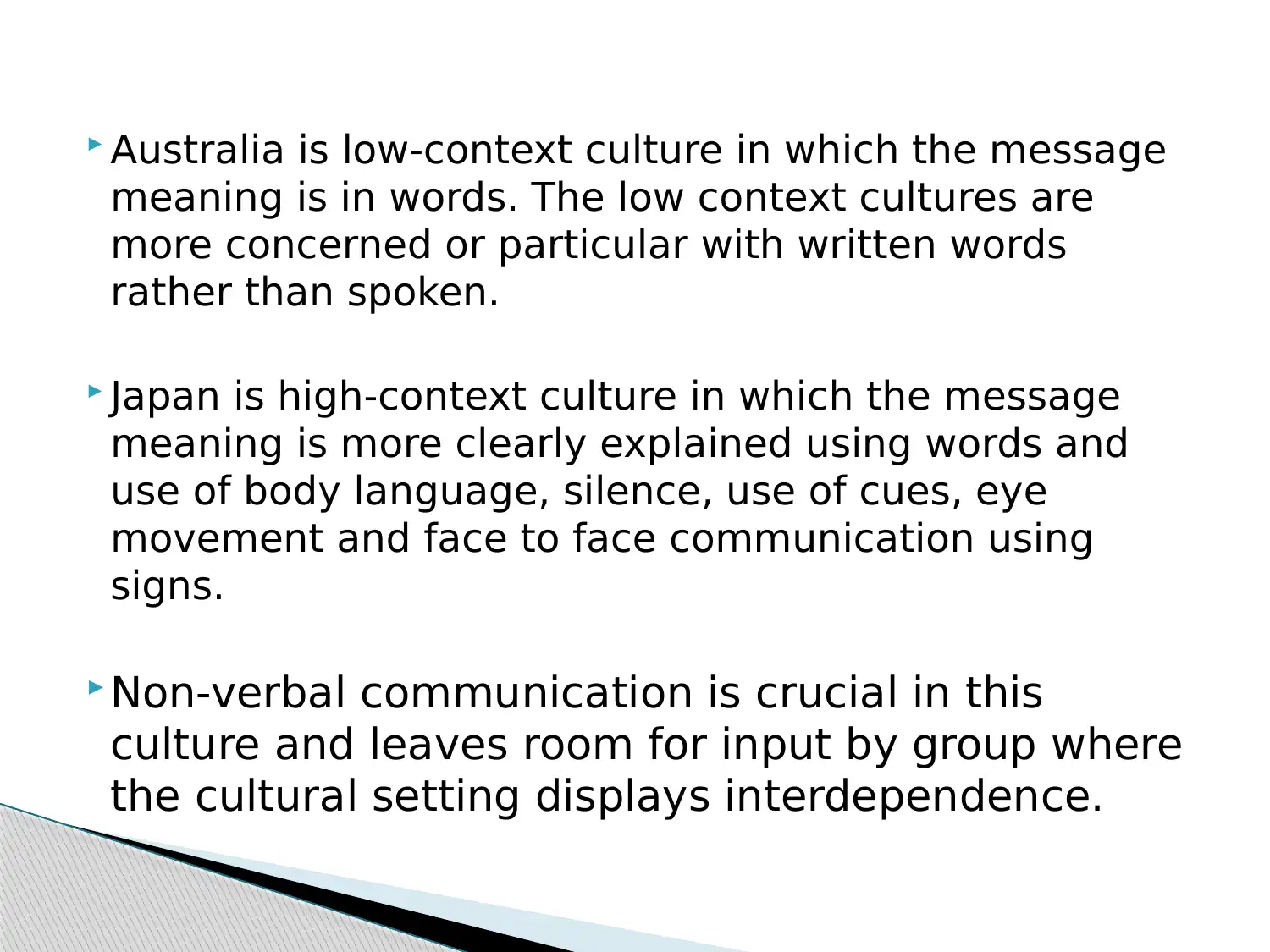
Australia is low-context culture in which the message
meaning is in words. The low context cultures are
more concerned or particular with written words
rather than spoken.
Japan is high-context culture in which the message
meaning is more clearly explained using words and
use of body language, silence, use of cues, eye
movement and face to face communication using
signs.
Non-verbal communication is crucial in this
culture and leaves room for input by group where
the cultural setting displays interdependence.
meaning is in words. The low context cultures are
more concerned or particular with written words
rather than spoken.
Japan is high-context culture in which the message
meaning is more clearly explained using words and
use of body language, silence, use of cues, eye
movement and face to face communication using
signs.
Non-verbal communication is crucial in this
culture and leaves room for input by group where
the cultural setting displays interdependence.
Paraphrase This Document
Need a fresh take? Get an instant paraphrase of this document with our AI Paraphraser
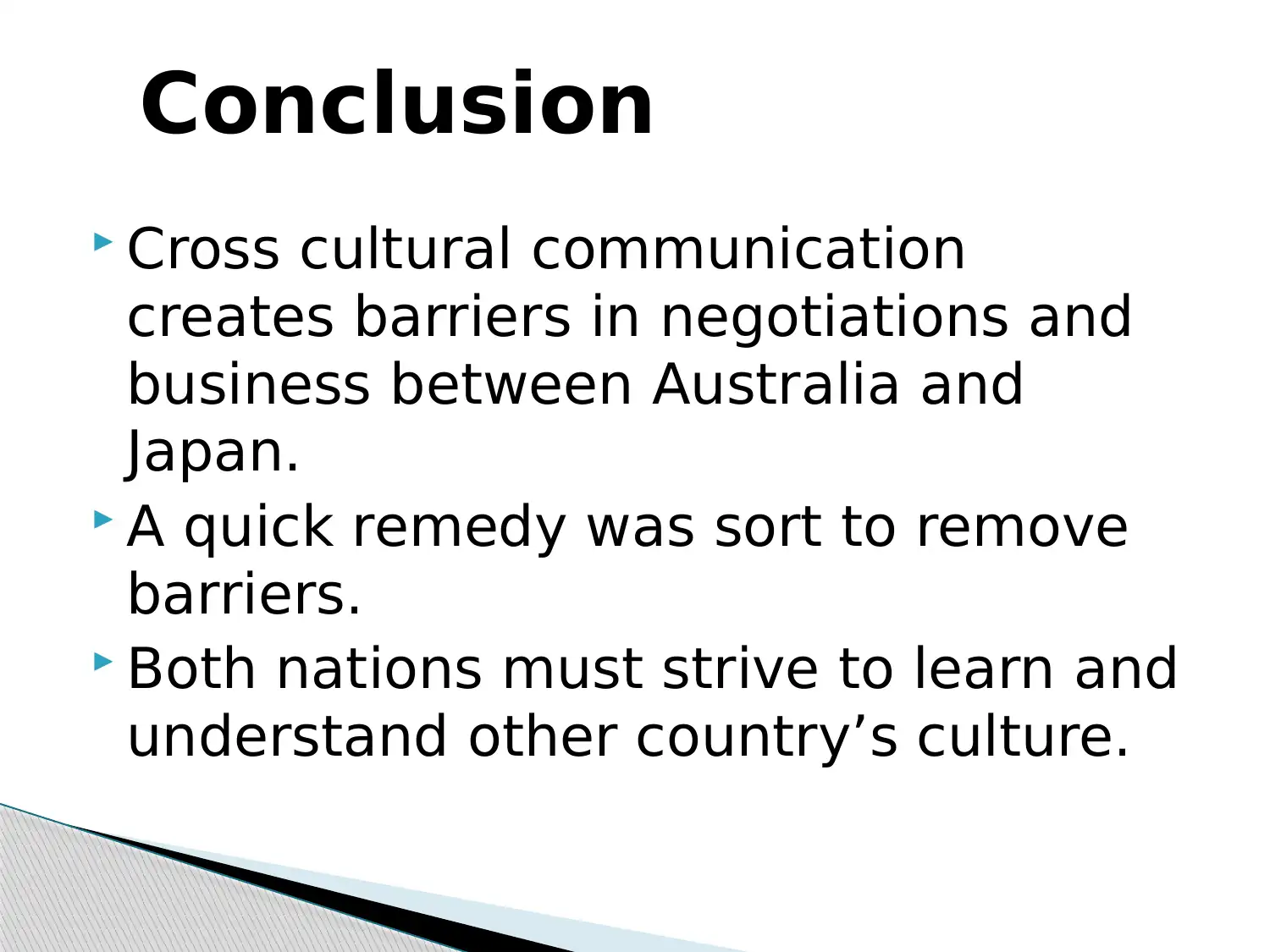
Conclusion
Cross cultural communication
creates barriers in negotiations and
business between Australia and
Japan.
A quick remedy was sort to remove
barriers.
Both nations must strive to learn and
understand other country’s culture.
Cross cultural communication
creates barriers in negotiations and
business between Australia and
Japan.
A quick remedy was sort to remove
barriers.
Both nations must strive to learn and
understand other country’s culture.
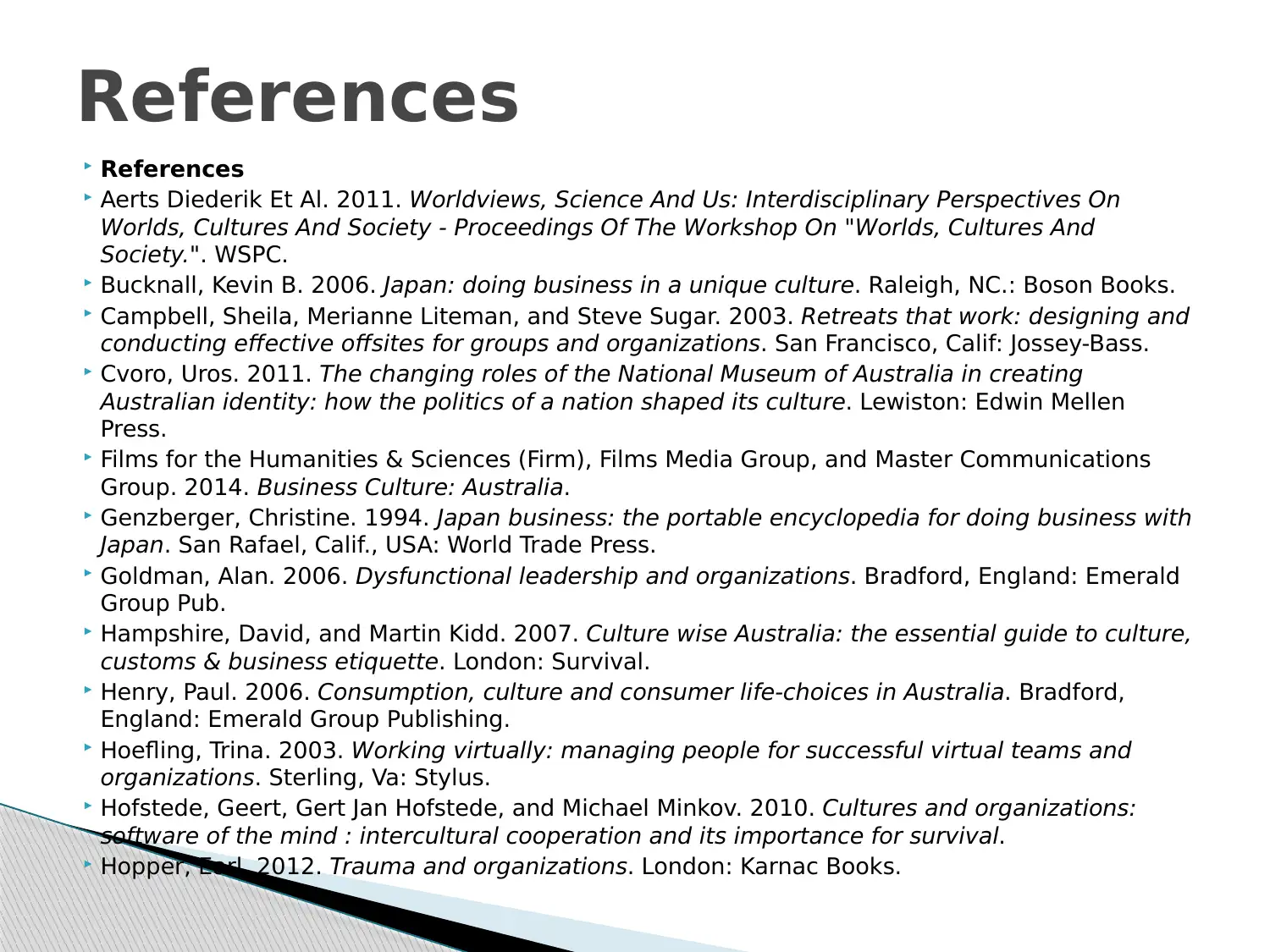
References
Aerts Diederik Et Al. 2011. Worldviews, Science And Us: Interdisciplinary Perspectives On
Worlds, Cultures And Society - Proceedings Of The Workshop On "Worlds, Cultures And
Society.". WSPC.
Bucknall, Kevin B. 2006. Japan: doing business in a unique culture. Raleigh, NC.: Boson Books.
Campbell, Sheila, Merianne Liteman, and Steve Sugar. 2003. Retreats that work: designing and
conducting effective offsites for groups and organizations. San Francisco, Calif: Jossey-Bass.
Cvoro, Uros. 2011. The changing roles of the National Museum of Australia in creating
Australian identity: how the politics of a nation shaped its culture. Lewiston: Edwin Mellen
Press.
Films for the Humanities & Sciences (Firm), Films Media Group, and Master Communications
Group. 2014. Business Culture: Australia.
Genzberger, Christine. 1994. Japan business: the portable encyclopedia for doing business with
Japan. San Rafael, Calif., USA: World Trade Press.
Goldman, Alan. 2006. Dysfunctional leadership and organizations. Bradford, England: Emerald
Group Pub.
Hampshire, David, and Martin Kidd. 2007. Culture wise Australia: the essential guide to culture,
customs & business etiquette. London: Survival.
Henry, Paul. 2006. Consumption, culture and consumer life-choices in Australia. Bradford,
England: Emerald Group Publishing.
Hoefling, Trina. 2003. Working virtually: managing people for successful virtual teams and
organizations. Sterling, Va: Stylus.
Hofstede, Geert, Gert Jan Hofstede, and Michael Minkov. 2010. Cultures and organizations:
software of the mind : intercultural cooperation and its importance for survival.
Hopper, Earl. 2012. Trauma and organizations. London: Karnac Books.
References
Aerts Diederik Et Al. 2011. Worldviews, Science And Us: Interdisciplinary Perspectives On
Worlds, Cultures And Society - Proceedings Of The Workshop On "Worlds, Cultures And
Society.". WSPC.
Bucknall, Kevin B. 2006. Japan: doing business in a unique culture. Raleigh, NC.: Boson Books.
Campbell, Sheila, Merianne Liteman, and Steve Sugar. 2003. Retreats that work: designing and
conducting effective offsites for groups and organizations. San Francisco, Calif: Jossey-Bass.
Cvoro, Uros. 2011. The changing roles of the National Museum of Australia in creating
Australian identity: how the politics of a nation shaped its culture. Lewiston: Edwin Mellen
Press.
Films for the Humanities & Sciences (Firm), Films Media Group, and Master Communications
Group. 2014. Business Culture: Australia.
Genzberger, Christine. 1994. Japan business: the portable encyclopedia for doing business with
Japan. San Rafael, Calif., USA: World Trade Press.
Goldman, Alan. 2006. Dysfunctional leadership and organizations. Bradford, England: Emerald
Group Pub.
Hampshire, David, and Martin Kidd. 2007. Culture wise Australia: the essential guide to culture,
customs & business etiquette. London: Survival.
Henry, Paul. 2006. Consumption, culture and consumer life-choices in Australia. Bradford,
England: Emerald Group Publishing.
Hoefling, Trina. 2003. Working virtually: managing people for successful virtual teams and
organizations. Sterling, Va: Stylus.
Hofstede, Geert, Gert Jan Hofstede, and Michael Minkov. 2010. Cultures and organizations:
software of the mind : intercultural cooperation and its importance for survival.
Hopper, Earl. 2012. Trauma and organizations. London: Karnac Books.
References
⊘ This is a preview!⊘
Do you want full access?
Subscribe today to unlock all pages.

Trusted by 1+ million students worldwide
1 out of 13
Related Documents
Your All-in-One AI-Powered Toolkit for Academic Success.
+13062052269
info@desklib.com
Available 24*7 on WhatsApp / Email
![[object Object]](/_next/static/media/star-bottom.7253800d.svg)
Unlock your academic potential
Copyright © 2020–2025 A2Z Services. All Rights Reserved. Developed and managed by ZUCOL.




